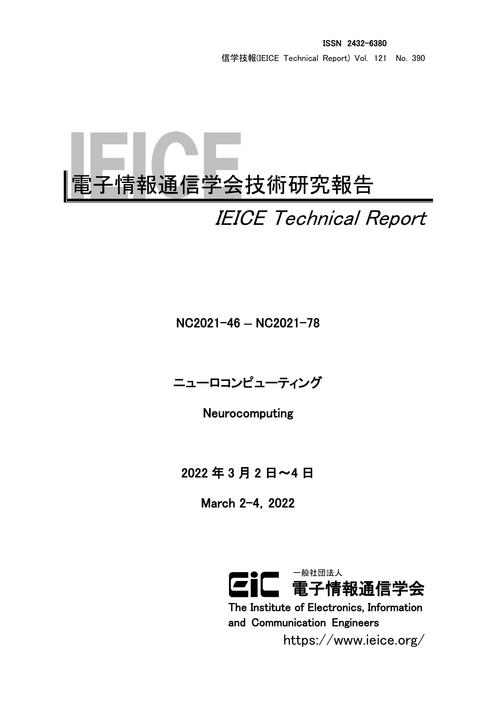

Online edition: ISSN 2432-6380
[TOP] | [2018] | [2019] | [2020] | [2021] | [2022] | [2023] | [2024] | [Japanese] / [English]
NC2021-46
A Study on Improvement of Recognition Accuracy and Speed-up of SOM-based Classification System
Shun Tasaka, Hiroomi Hikawa (Kansai Univ.)
pp. 1 - 4
NC2021-47
(See Japanese page.)
pp. 5 - 10
NC2021-48
A Glass Breaking Sound Detection Method for Security Systems using SVM
Yuhei Mazaki, Susumu Kuroyanagi (NIT)
pp. 11 - 16
NC2021-49
Learning of a stacked autoencoder with regularizers added to the cost function, evaluation of their effectiveness, and clarification of its information compression mechanism
Masumi Ishikawa (Kyutech)
pp. 17 - 22
NC2021-50
A simple reinforcement learning of state-dependent PD feedback gains for stabilizing an inverted pendulum invokes the intermittent control strategy.
Tomoki Takazawa, Yasuyuki Suzuki, Akihiro Nakamura, Taishin Nomura (Osaka Univ.)
p. 23
NC2021-51
Machine learning-based method for estimating saccade offset points from electrooculogram
-- The evaluation of the consistency of estimated offset points by eye-fixation-related potentials --
Takuma Saga, Hiroki Watanabe, Yasushi Naruse (NICT)
pp. 24 - 29
NC2021-52
Development and evaluation of a neurofeedback system for motor-imagery based BCI
Shuhei Oba, Simon Kojima, Shin'ichiro Kanoh (SIT)
pp. 30 - 35
NC2021-53
Effects of subjective task criteria of sword motion in Kendo swinging
Hayato Ogino, Yutaka Sakaguchi (UEC)
pp. 36 - 41
NC2021-54
The effect of visual stimulus on standing posture control
Mitsuharu Murata, Chika Yamane, Jun Nishii (Yamaguchi Univ.)
pp. 42 - 45
NC2021-55
A Pertinent Parameter Adjustment by Genetic Algorithm for a Tracking Radar Filter
Fumito Watano, Toshihiko Fukue (ATLA)
pp. 46 - 49
NC2021-56
(See Japanese page.)
pp. 50 - 55
NC2021-57
(See Japanese page.)
pp. 56 - 61
NC2021-58
XMCD-CT Reconstruction Using Compressed Sensing
Tsukito Takizawa, Hayaru Shouno (The Univ. of Electro-Communications), Masaichiro Mizumaki (JASRI), Motohiro Suzuki (Kwansei Gakuin Univ.)
pp. 62 - 67
NC2021-59
Verification of a Visuomotor Integration Model using CNN and Depth Image for Robot Hand Control
Mai Ohashi, Motoi Matsuda, Satoshi Katayama, Naohiro Hukumura (Toyohashi Univ of Tech)
pp. 68 - 73
NC2021-60
Estimating the permeability of rocks using three-dimensional CNN and ResNet
Taro Kamano (Kyushu Univ.), Yutaka Jitsumatsu (Tokyo Tech), Takeshi Tsuji (Kyushu Univ.)
pp. 74 - 79
NC2021-61
A comparative study of mathematical models for resting brain activity through simulation
Masanori Ue (NAIST/ATR), OkitoYamashita (ATR)
pp. 80 - 81
NC2021-62
A General‐purpose Answering System to Visuo-linguistic Instructions based on a DALLE-based Architecture
Shotaro Sakaguchi, Tatuji Munaka, Hiroki Kurashige (Tokai Univ)
pp. 82 - 87
NC2021-63
Basic characteristics of SAM spiking neuron model with rate coding
Minoru Motoki (Kumamoto KOSEN)
pp. 88 - 93
NC2021-64
Designing a Brain Reference Architecture for Double Articulation Analyzer of Spoken Language
Maoko Muro, Akira Taniguchi (Ritsumeikan), Hiroshi Yamakawa (WBAI/UTokyo/RIKEN), Tadahiro Taniguchi (Ritsumeikan)
pp. 94 - 99
NC2021-65
Mechanism hypothesis for governing imagination by coordination of type I/II pyramidal cells in the claustrum
Ayako Fukawa (WBAI), Hiroshi Yamakawa (WBAI/The Univ. of Tokyo)
pp. 100 - 105
NC2021-66
EEG style transfer for sleep stage scoring using deep learning
Naoki Omiya (Univ. of Tsukuba), Kazumasa Horie (CCS), Hiroyuki Kitagawa (IIIS)
pp. 106 - 111
NC2021-67
A study on hit classification by machine learning of Japanese popular music using Spotify Audio Features
Kengo Kitamura, Susumu Kuroyanagi (NIT)
pp. 112 - 117
NC2021-68
[Short Paper]
Investigation of brain activity related to rhythm deviation in music
Ming Chang (NICT), Taro Maeda (Osaka University), Yasushi Naruse (NICT)
pp. 118 - 120
NC2021-69
An estimation method of missing Information of compressed sound source using the Deep U-Net as an Auto-Encoder
Kazuma Hirai, Susumu Kuroyanagi (NITech)
pp. 121 - 126
NC2021-70
A Method of Generating Frequency Modulation Sounds Based on Onomatopoeia Using Interactive Genetic Algorithm
Atsuya Tsuchida, susumu kuroyanagi (NITech)
pp. 127 - 132
NC2021-71
A Kalman filter model for adaptation to delayed auditory feedback
Nobuhiko Asakura (Osaka Univ.), Takafumi Sasaoka (Hiroshima Univ.), Kenji Ogawa (Hokkaido Univ.), Toshio Inui (Otemon Gakuin Univ.)
pp. 133 - 137
NC2021-72
Observational learning with an entorhinal-hippocampal spiking neural network encoding the position of self and other
Katsuya Chiguchi, Katsumi Tateno, Kensuke Takada (Kyutech)
p. 138
NC2021-73
Temporal modulation of neural activities: an approach with a multiple-timescale neural network
Tomoki Kurikawa (Kansai Med Univ)
pp. 139 - 142
NC2021-74
Investigation of machine learning methods for emotion discrimination by using phase synchronization of electroencephalogram
Fumiya Hirooka, Jiro Okuda (Kyoto Sangyo Univ. Grad. Sch.)
pp. 143 - 148
NC2021-75
EEG classification with Aligners and Adversarial Domain Adaptation for Invariant Feature Extraction and Calibration Across Subjects
Tatsuhiro Shiraishi (NAIST), Reinmar Kober, Kazuaki Kawanabe (ATR)
pp. 149 - 154
NC2021-76
Qualitative data analysis to explore classes of curiosity toward various objects
Momoka Yamazaki, Hiroki Kurashige (Tokai Univ.)
pp. 155 - 157
NC2021-77
Influence of a verbal load on a sequential timing task
Takashi Oyama, Teruaki Ito (Okayama Pref. Univ.)
pp. 158 - 163
NC2021-78
Investigation of event-related potentials elicited by attribute change of virtually localized moving sound
Fumiya Kobayashi, Simon Kojima, Shin'ichiro Kanoh (SIT)
pp. 164 - 169
Note: Each article is a technical report without peer review, and its polished version will be published elsewhere.